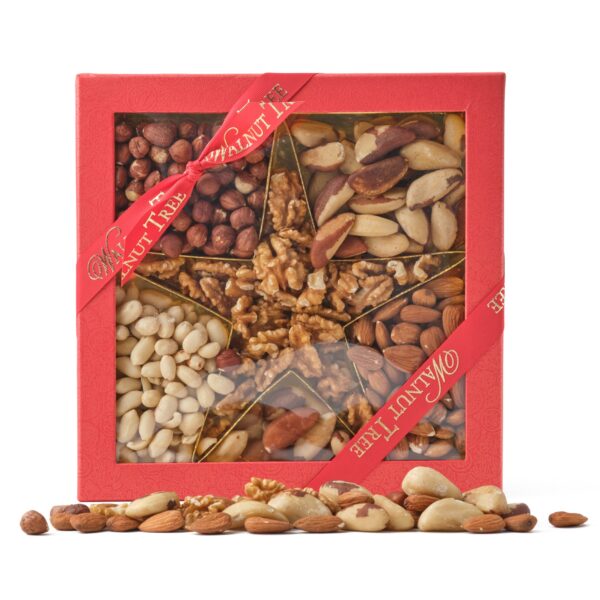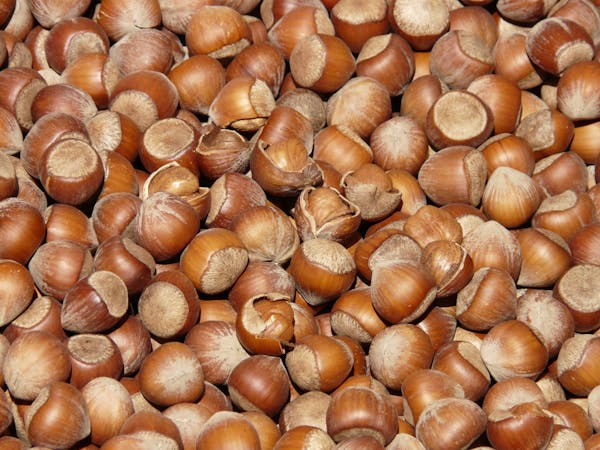Tudors and the Highly Favoured Hazelnut
Tudors and the Highly Favoured Hazelnut. The life and times of King Henry VIII of England are turbulent and chaotic on the best of days. His reign includes his six wives, the Protestant Reformation, breaking from the Catholic Church, and his violent mood swings. Yet, in the early days, his reign was seen as a time of hope following his father’s death, King Henry VII, and his brother, Prince Arthur.
Snack and meal times took place with luxury, decadence, indulgence, and fanfare. Everywhere Henry VIII went; his entire entourage went with him to his palaces and homes of nobility. The cost then, and today’s money, is high. The Tudor dynasty continues with his son, Prince Edward, and daughters, Princess Mary and Princess Elizabeth. Each eventually wore the crown in their own right as king or queen.
Historical records show Henry VIII was fond of hazelnuts, spit roast meats, game animals, sweet preserves, fish, butter, pottages, fritters, pies, eggs, cockentrice, and roasted swan. His formal state banquets could include fourteen courses with a peacock as the centerpiece.
Imagine courtiers eating 5,000 calories a day!
This blog will focus on one aspect of Henry VIII’s favourites list—hazelnuts.
Let’s dive further into the names, origins, additional history, and uses of hazelnuts.
What names do the British have for hazelnuts?
Hazelnuts are the common name given to the “king of all nuts.” The term hazelnut is derivative of the
Anglo-Saxon word “haesel.” Before the 20th century, hazelnuts were known as filberts and cobnuts. The
filbert refers to the husk or beard encasing the nut when it is ripe. The term cobnut comes from a game
British children use to play with nuts.
Hazelnuts, are they native to Great Britain?
Yes, hazelnuts come from the hazel tree, a native species in the UK, and are a member of the birch
family. The hazel tree grows in woodland, hedgerows, and scrubland. The Latin name for the hazel tree
is Corylus arellana. A healthy hazel tree can produce nuts for over 60 years. Nutting or Cobnut season is
August to October. Traditionally, the season begins on 20 August on St. Philbert’s Day. St. Philbert was a
French priest whose feast fell on that date. Stone Age sites show hazelnuts were eaten in Scotland,
Sweden, Germany, and Denmark. The oldest known site was the Island of Colonsay, Scotland.
Hazelnut, their Origins
The earliest known references to hazelnuts being grown are in ancient China. Some of the best
hazelnuts in the world come from Turkey. Approximately 58 percent of the world’s hazelnut crop comes
from there. The Greeks and Romans grew and ate hazelnuts, too. Sometimes, the nuts were part of the
medicine for baldness. Hazelnuts were eventually sent from Great Britain to the Americas, symbolising
wisdom, knowledge, good luck, fertility, and inspiration in Celtic and Irish traditions. For Christians, the
nuts represent the Trinity. They are also part of magic, prophesy, and protection. This cultural history of
hazelnuts connects to the past and different cultures’ diverse beliefs and practices.
Hazelnut and Tudor Times
During Henry VIII’s reign, hazelnuts were a staple in the Tudor diet. The nuts were eaten in various
forms, including dried, caramelised, or roasted. The Tudors typically ate three meals a day. Their meals
brought hazelnuts into their breakfast, dinner, and supper. These versatile nuts were also ground up and
used in sweet desserts like tarts, custards, Marzipan, pies, and other delicacies. The nut’s buttery, earthy
flavour, and simple, sweet undertone made it a popular ingredient. However, due to the high cost of
sugar, honey, herbs, and spices were often used to flavor these dishes.
In 1989 and 2010, archaeologists could establish that Tudor theatre attendees ate hazelnuts alongside
walnuts, raisins, plums, cherries, oysters, dried figs, crabs, cockles, and peaches while watching
Christopher Marlowe and William Shakespeare’s play performances at The Globe and The Rose
Playhouse during Queen Elizabeth I’s reign. These foods are the fast food options for the wealthier
classes. Wealthy people sat in the galleries to watch shows while poorer theater-goers stood in the yard
(front stage).
Piles of hazelnut shells left are stage front and center. Archaeologists call hazelnuts
“Elizabethan popcorn.” Walking on hazelnut shells doesn’t sound any better than walking on eggshells. If
one doesn’t wear proper shoes, it sounds absolutely dreadful, sharp, and painful.

Hazelnut, Modern Times and Uses
Today, Hazelnuts are primarily a snack, useful in baking and breakfast cereals, and part of a nutritious
and healthy diet. The nuts provide cholesterol-free energy and contain vitamins B and E and healthy fats
like omega-3s. According to Food Print, a project of GRACE Communications Foundation, Ferrero, maker of Nutella, uses 25 percent of the world’s supply of hazelnuts annually. They estimate that it is 50
hazelnuts per jar. This information about the nutritional value of hazelnuts can help people make good
choices about their diet and health.
Snacks and meals in Tudor times weren’t just about the food. They were about the queen and king’s
power and how they showed off their wealth. The wealthier classes ate more meats and some fruits and
tried to avoid vegetables. For some royalty and courtiers, plant-based foods are suspicious even if they
were regularly on the table. The poor classes couldn’t afford red meat and ate more vegetables. It is
believable that they had healthier diets than those of the royal family or nobility. Hazelnuts were a
Henry VIII favourite and for many at his court.
The nuts can still be readily available in UK grocery stores, brick-and-mortar retailers, and online retailers—Tesco, Aldi, Ark Wildlife, or Walnut Tree (walnut.gifts).
About Walnut Tree- the finest edible gifts
Great Taste Awards
With Great Taste Awards for nougat, dried fruit, marron glacé, glacé fruit and pate de fruit. You’ll always be purchasing quality products from Walnut Tree.
Who we supply
Supplied under own brand or white label to prestigious stores, palaces, castles, stately homes, garden centres, delicatessens, farm shops, hamper companies, department stores and gift shops.
Why buy from us?
You’re buying directly from the source and will get excellent value for money. If you’re not happy with your purchase, we’ll refund or replace it. The website is open 24/7, orders despatched within 48 hours.
Our charitable contributions
Walnut Tree supports Future Dreams Breast Cancer Charity with dried fruit for their care packages. www.futuredreams.org.uk
Local areas to our factory
AL1 | AL2 | AL3 | AL9 | AL10 | EN6 | EN5 | EN4 | NW4 | NW7 | NW9 | WD6 | WD7 | WD17 | | WD19 | WD23 | WD24 | WD25 | Aldenham | Barnet | Borehamwood | Brent X | Bushey | Colney Street | Edgware | Elstree | Finchley | Frogmore | Hatfield | Hendon | Hertfordshire | Hertsmere | Leavesden | London Colney | Mill Hill | New Barnet | North London | Potters Bar | Radlett | Shenley | South Mimms | Stanmore | St. Albans | Southgate | Watford | Welham Green | Whetstone | Woodside Park


